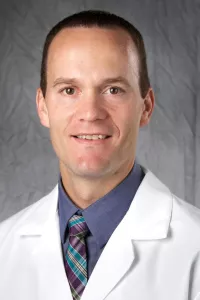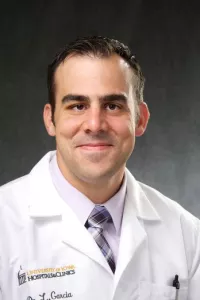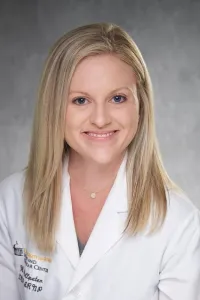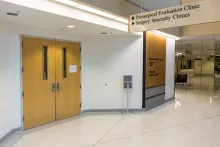Hernias
A hernia occurs when an organ (usually the intestine) or fatty tissue protrudes through a weak spot in the surrounding muscle or connective tissue.
The most common types of hernias include:
- Incisional/ventral (at the site of a previous surgery)
- Inguinal (groin)
- Umbilical (belly button)
Signs and symptoms of hernias
Most people with a hernia will notice a bulge or mass at the site of the hernia. Common places include noticing a bulge in the groin/scrotum or in the abdomen, either at the belly button or at the site of a previous surgical incision. The bulge can usually be pushed back in.
A lot of people will also have pain associated with the hernia. This may include tenderness, abdominal pain, or back pain. If the hernia becomes very painful or the bulge cannot be pushed back in then you should call your doctor and be evaluated.
Treatment options
Once present, hernias will not go away on their own. Some people find relief with wearing an abdominal binder and a truss. While this may help the symptoms, it does not fix the hernia. Over time, most patients will have enlargement of the hernia and symptoms will increase. The only definitive treatment for hernias is surgery.
Surgery involves suturing the muscle or fascia back together and placing a piece of mesh to reinforce the area. The use of mesh has been shown to reduce the chance that the hernia will come back.
Surgery is either done laparoscopically or through an open incision. This decision is based on the size and location of the hernia. Our team at the UI Health Care Hernia Center will work with each patient to find the best surgical option for you.
- Advanced Component Separation Techniques:
- Allow the muscles to be able to sutured back together
- Used in patients with very large hernias
- We have specialists trained in advanced techniques used to fix incisional hernias
- Some of these advanced techniques include anterior component separation, posterior component separation, and transversus abdominis release
- Laparoscopic Incisional Hernia Repair:
- Best for patients with few previous hernia repairs or abdominal surgery and smaller sized hernias
- Involves using small incisions and a video camera to repair a hernia
- Steps are similar to that of an open hernia repair
- Hernia contents are pulled back into the abdominal cavity
- Hernia is sutured closed
- A mesh is placed
- Open Incisional Hernia Repair:
- Involves making an incision over the site of the hernia
- Steps in this procedure involve
- Pushing the contents of the hernia back inside the abdominal cavity
- Closing the hernia with sutures
- Placing a mesh to reinforce the area
- Used in patients with a history of large hernias, multiple previous abdominal surgeries, and multiple previous hernia repairs
- Soft Tissue Reconstruction:
- Patients with large hernias and/or multiple previous hernia repairs will have excess skin and scars that will need to be removed at the time of surgery
- Our plastic surgeons will assist with excision of excess skin and scar revision
What to expect from hernia surgery
With millions of procedures performed in the world every year, hernia repairs are some of the most common surgical procedures. General surgeons typically manage hernia repairs, though in recent years many medical institutions have turned to dedicated hernia centers.
Hernia surgery can be either done as an outpatient (usually for small umbilical hernias and groin hernias) or require admission to the hospital after surgery (bigger incisional hernias). There will be pain associated with surgery, but this is easily controlled with pain medications. Most people are able to return back to work within 2 weeks after surgery.
There will be lifting restrictions after surgery. The duration of this depends on each individual patient and the extent of surgery required to repair the hernia.
Hernia repairs vary from relatively uncomplicated to complex procedures. This may be due to several factors including:
- Hernia location
- Level of distortion in the abdominal wall's anatomy
- Previous attempts at hernia repair
- Size of the hernia
Risks of hernia surgery
The risks of surgery depend on the size and location of the hernia as well as the surgical procedure chosen to repair your hernia. Patient's medical conditions can also increase the risk of surgery. These include diabetes, smoking, obesity, and previous attempts at repair of the hernia.
The most common risks from surgery include an infection at the site of surgery. We work with each patient to optimize them for surgery to have the best possible outcomes.
Hernia Center Protocols
The Hernia Center's specialists use care protocols to ensure each patient receives individualized care based on his or her specific diagnosis. This is achieved through a focus on patient-centered outcomes, and may include care protocols such as:
- BMI restrictions and weight loss support surgery
- Glucose control/optimizing hemoglobin A1c in all diabetic patients
- Indications for advanced imaging
- Involvement in multicenter trials
- Tobacco cessation
Multidisciplinary team with a patient-centered approach
The Hernia Center is your central location for all hernia care and repairs. We are staffed with specialists from General Surgery, Plastic Surgery, and Minimally Invasive/Bariatric Surgery. We are prepared to handle all types of hernia repairs with a patient-centered approach, choosing the best surgical procedure for each individual patient.
Time and research have shown that patient outcomes are related to surgeon experience regardless of whether the hernia repair is routine or complex. We bring together the right team for your care at UI Health Care Hernia Center. With a staff of physicians adept at open surgery, minimally invasive techniques, and plastic-reconstructive surgery, the Hernia Center is able to adapt to each patient's specific needs. This specialty care leads to improved clinical outcomes and patient satisfaction.
Our Care Team meets each month to discuss complex patients, performance improvements, patient outcomes, and research related to improving hernia repair. We utilize evidence-based protocols designed to optimize patients for surgery and achieving the best possible outcomes.
Our Care Team




- Lung Services
- Surgery
- Transplant

Not sure which Hernia Center provider is right for you?
Locations and Offices
